An ancient man-made blue and white glass from Ispahan, Iran
- Details
- Created: Monday, 29 August 2016 10:58
The piece of blue and white material shown in figure 1 was submitted for analysis. Initially proposed as blue quartz, it also looks like some blue and white sodalite.
Such kind of material comes from Iran and seems to be very scare, anyway it is rather unusual.
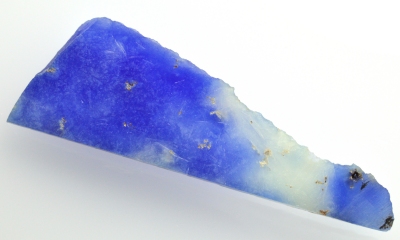 Figure 1. A 40 x 14 x 4 mm slice of the unknown blue material.
Figure 1. A 40 x 14 x 4 mm slice of the unknown blue material.| Shape | slice |
| Size | 40 x 14 x 4 mm |
| Color | Slighly violetish-blue and white |
| Lustre | vitreous |
| Weight | 16.15 ct |
| SG | 2.42 |
| RI | ~1.51 |
| DR | - |
| Pleochroism | none |
| Polariscope / Conoscope | stays light through 360° -> polycrystalline ? |
| SWUV | inert |
| LWUV | inert |
| Magnetic susceptibility | none |
Table 1. Observational and measured properties
The slice's cut sides were polished with brown cerium oxide powder in order to read a refractive index and to obtain a reflectance spectrum. Even with the polished surface, reading RI was not obvious and the result is a single index around 1.51 whatever the read area (blue or white). The slice placed in between the polariscope filters, stayed light in all directions in the blue part as well as in the white part.
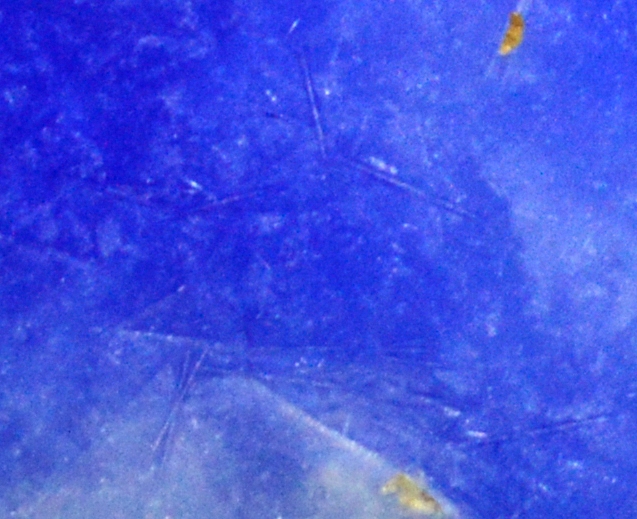 Figure 2. The inhomogeneous color the material observed from the polished side of the slice of the picture 1, the field of view is about 6 mm. All the main features can be observed, the irregular cavities, the blue color mixed with white 'breadcrumb' clusters, the elongated and thin whitish 'crystals' randomly oriented.
Figure 2. The inhomogeneous color the material observed from the polished side of the slice of the picture 1, the field of view is about 6 mm. All the main features can be observed, the irregular cavities, the blue color mixed with white 'breadcrumb' clusters, the elongated and thin whitish 'crystals' randomly oriented.The uncut side of the slice (4 mm wide) is irregular and looks like some quartz pebbles surfaces. Two small half spherical cavities are present. On cut and polished sides, the the cavities are irregular with sometime tiny elongated crystals covering their inner side. Those cavities are now filled with the brown polishing powder as it can be observed in pictures.
The color is inhomogeneous, mixing white and blue. The white color within the blue areas seems to be the result of clustered grains of white material (figure 2) like snow or freeze or even breadcrumb. Numerous elongated and thin mostly whitish 'crystals' are randomly oriented in the material. The blue color is often more intense around them. These crystals do exist in the white areas and then they look like mostly slightly blue.
Infrared reflectance spectroscopy:
The IR reflectance spectra were obtained from one of the polished side of the slice, some from the blue area and the others from the white area. Both spectra are identical, therefore only one is shown in figure 3.
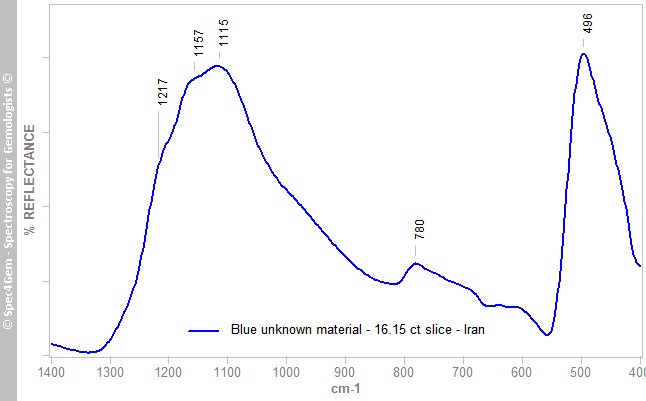 Figure 3. IR reflectance spectrum acquired from the polished side (picture 1) of the slice. Both blue and white material show the same spectrum. The overall pattern of the spectrum indicates the material is a silica material, with the asymmetric Si-O-Si stretching vibrations revealed by the wide and strong bands in the 900 to 1300 cm-1 region. The 783 cm-1 band is the result of Si-O-Si bending and the features in the 400 to 550 cm-1 region are the result of the bending and rocking Si-O-Si vibrations.
Figure 3. IR reflectance spectrum acquired from the polished side (picture 1) of the slice. Both blue and white material show the same spectrum. The overall pattern of the spectrum indicates the material is a silica material, with the asymmetric Si-O-Si stretching vibrations revealed by the wide and strong bands in the 900 to 1300 cm-1 region. The 783 cm-1 band is the result of Si-O-Si bending and the features in the 400 to 550 cm-1 region are the result of the bending and rocking Si-O-Si vibrations. The overall pattern of the spectrum indicates the material is a silica material, that is identified by the asymmetric Si-O-Si stretching vibrations revealed by the wide and strong bands in the 900 to 1300 cm-1 region and the bending and rocking Si-O-Si vibrations in the 400 to 550 cm-1 region. These two main reflectance band groups are usually accompanied by weaker bands, as the result of Si-O-Si bending vibrations around 770-780 cm-1.
The asymmetric Si-O-Si stretching vibrations bands are usually separated in two known bands attributed to the TO and LO modes, respectively the transversal and longitudinal optical phonon modes. The TO's band is the one around 1100 cm-1 and the LO's band is the one around 1200-1250 cm-1. The position and intensity of the LO's band varies according to several factors (not addressed in this report). These two bands can distinctively be observed in tektites and opals spectra as shown in figure 4, although they are not for the studied material. Moreover, there is a third and unusual band in the middle around 1160 cm-1.
A search into the IR reflectance database did not return a perfect match but only approaching spectra matches with opals, tektites (natural glasses), and to a less extend with artificial glasses because of the bands positions that significantly differ. A selection of the matching spectra are shown in figure 4, all of them were 'normalized' and shifted for clarity.
It is not possible to determine the nature of this material yet. The IR reflectance spectrum is not yet known in the database and even if it shows some similarities with common silica like opals, tektites and artificial glasses, it is impossible to conclude without further studies.
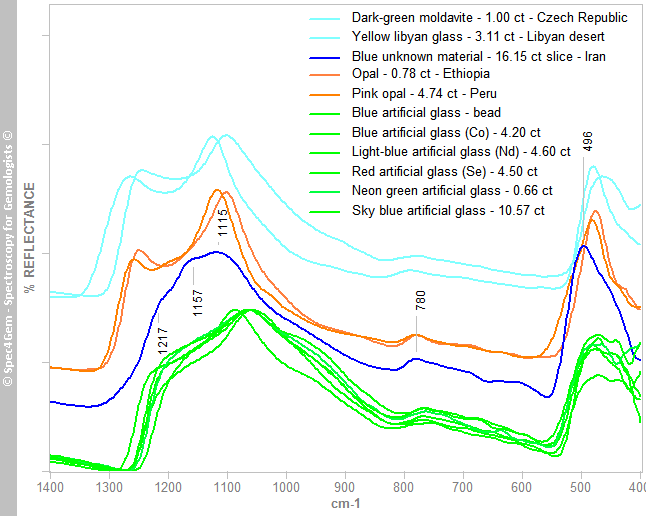 Figure 4. IR reflectance spectra of closest matching materials. All spectra are normalized and shifted for clarity. The blue material spectrum differs from others, especially on Si-O-Si asymmetric stretching vibrations bands (900 - 1300 cm-1) and bending and rocking vibrations bands (400 - 550 cm-1).
Figure 4. IR reflectance spectra of closest matching materials. All spectra are normalized and shifted for clarity. The blue material spectrum differs from others, especially on Si-O-Si asymmetric stretching vibrations bands (900 - 1300 cm-1) and bending and rocking vibrations bands (400 - 550 cm-1).UV-VIS-NIR spectroscopy:
The UV-Vis spectrum was acquired with a light path perpendicular to the polished side of the slice. The material being mostly translucent and the light path being 4 mm, acquiring data from the UV spectral range was impossible.
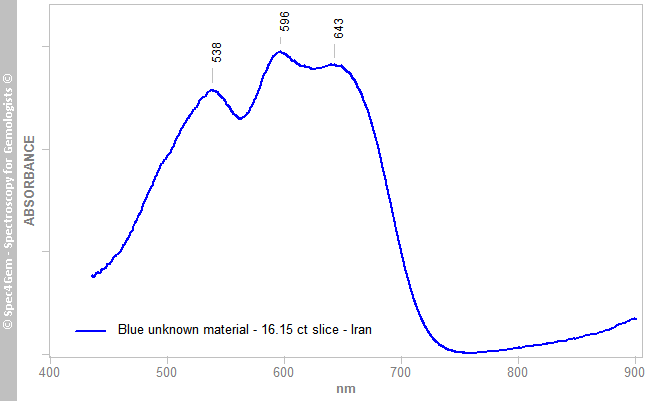 Figure 4. UV-Vis spectrum obtained from the blue part of the slice. A triplet band with absorption at 538, 596 and 643 nm defines the spectral pattern of the material.
Figure 4. UV-Vis spectrum obtained from the blue part of the slice. A triplet band with absorption at 538, 596 and 643 nm defines the spectral pattern of the material.The UV-Vis spectrum represented in figure 4 shows a spectral pattern based on a triplet band with absorption at 538, 596 and 643 nm. The material absorbing the visible spectrum from the green to the red lets the blue transmitted giving the material the strong blue color. Such a triplet band is usually observed in material colored by cobalt, with common examples that are blue spinel (natural and man-made), man-made blue glasses. The UV-Vis absorption spectrum is provided for comparison in figure 5, spectra are mostly identical.
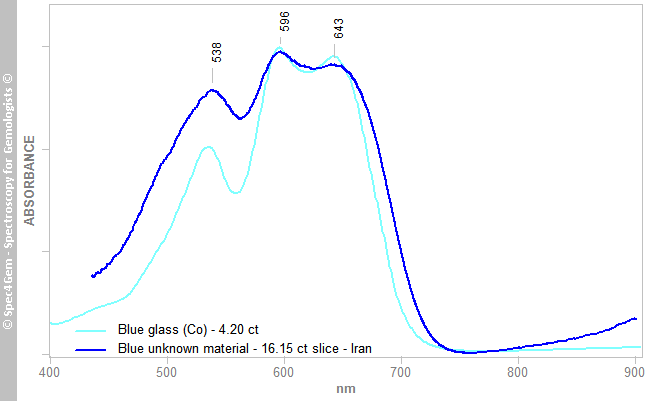 Figure 5. Comparison of the blue material uv-vis spectrum with that of a cobalt colored man-made glass.
Figure 5. Comparison of the blue material uv-vis spectrum with that of a cobalt colored man-made glass.
The UV-Vis spectrum of natural Co-bearing spinels has a similar triplet band except the triplet is narrow. Man-made Co-doped spinels with their steal-blue color have a fully similar spectrum to that of their natural counterpart except they lack the iron absorption around 450 nm.
The closest spectrum is the spectrum of the blue man-made glass colored by cobalt.
Photoluminescence spectroscopy:
No photoluminescence observed with the following excitation sources: 254, 280, 365 and 405 nm.
Conclusion:
IR spectroscopy identifies the material as a silica which is not a crystalline or polycrystalline quartz nor a sodalite as it could be expected from its general appearance. However, IR spectroscopy could not identified precisely the material because of the lack of similar material in the database. The man-made glass cannot be ignored even if the existing spectra did not precisely match.
The physical properties are consistent with man-made glasses with a RI of almost 1.51 and a SG of 2.42. The polariscope indicates a polycrystalline material that is not the case of glasses except if they sometime show an anomalous anisotropy.
The material presents few 'bubble' cavities that are common in glasses.
The UV-Vis spectroscopy shows a strong similarity with the man-made glasses colored by cobalt. Cobalt is not known to be coloring the natural glasses.
The material is possibly a kind of glass colored by cobalt of man-made origin.
Update from field on 09/17/2016, the material is found close to ancient foundry in the desert located 300 km from Ispahan, Iran. This is consistent with the results of the study and it confirms the material is an ancient man-made glass colored by cobalt. The IR spectral differences could possibly explained by different temperature of melting compared to modern glasses.

